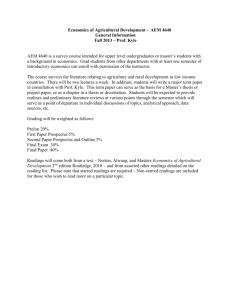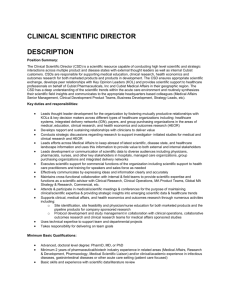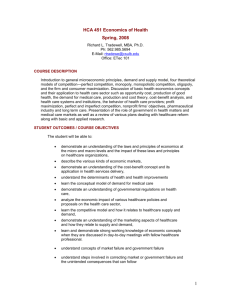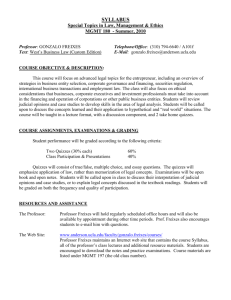MGMP 603 Health Care Economics - California State University
advertisement
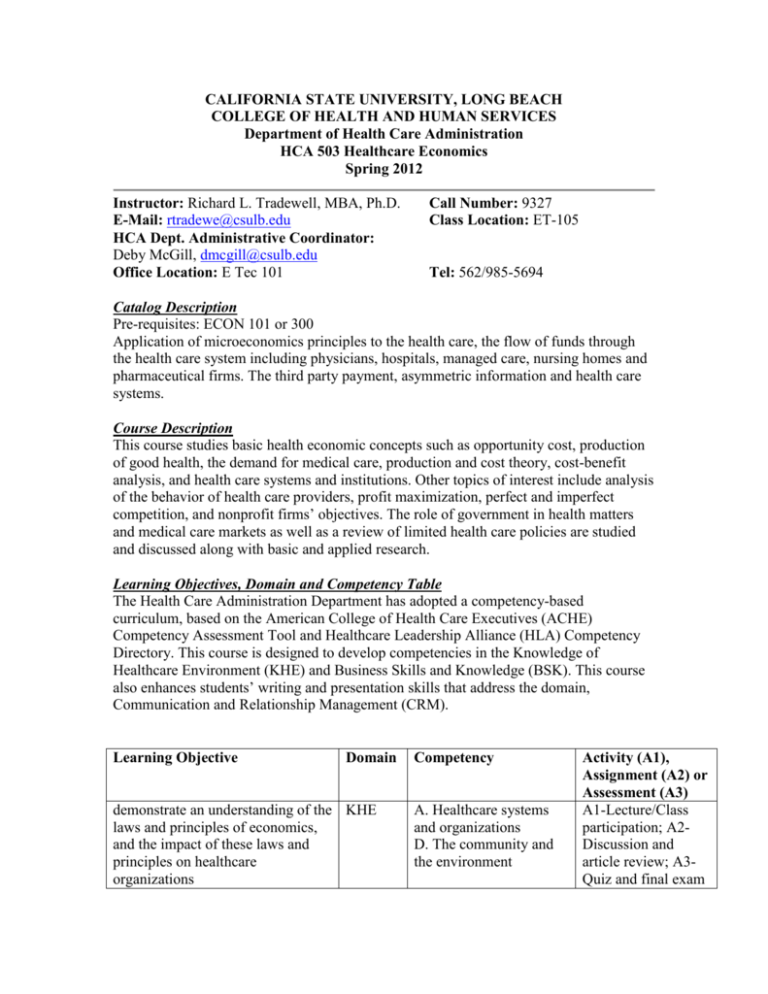
CALIFORNIA STATE UNIVERSITY, LONG BEACH COLLEGE OF HEALTH AND HUMAN SERVICES Department of Health Care Administration HCA 503 Healthcare Economics Spring 2012 Instructor: Richard L. Tradewell, MBA, Ph.D. E-Mail: rtradewe@csulb.edu HCA Dept. Administrative Coordinator: Deby McGill, dmcgill@csulb.edu Office Location: E Tec 101 Call Number: 9327 Class Location: ET-105 Tel: 562/985-5694 Catalog Description Pre-requisites: ECON 101 or 300 Application of microeconomics principles to the health care, the flow of funds through the health care system including physicians, hospitals, managed care, nursing homes and pharmaceutical firms. The third party payment, asymmetric information and health care systems. Course Description This course studies basic health economic concepts such as opportunity cost, production of good health, the demand for medical care, production and cost theory, cost-benefit analysis, and health care systems and institutions. Other topics of interest include analysis of the behavior of health care providers, profit maximization, perfect and imperfect competition, and nonprofit firms’ objectives. The role of government in health matters and medical care markets as well as a review of limited health care policies are studied and discussed along with basic and applied research. Learning Objectives, Domain and Competency Table The Health Care Administration Department has adopted a competency-based curriculum, based on the American College of Health Care Executives (ACHE) Competency Assessment Tool and Healthcare Leadership Alliance (HLA) Competency Directory. This course is designed to develop competencies in the Knowledge of Healthcare Environment (KHE) and Business Skills and Knowledge (BSK). This course also enhances students’ writing and presentation skills that address the domain, Communication and Relationship Management (CRM). Learning Objective Domain demonstrate an understanding of the KHE laws and principles of economics, and the impact of these laws and principles on healthcare organizations Competency A. Healthcare systems and organizations D. The community and the environment Activity (A1), Assignment (A2) or Assessment (A3) A1-Lecture/Class participation; A2Discussion and article review; A3Quiz and final exam 2 Learning Objective Domain describe the various kinds of health care markets KHE BSK Activity (A1), Assignment (A2) or Assessment (A3) A. Healthcare systems A1-Lecture/Class and organizations participation; A2D. The community and Discussion and the environment article review; A3Quiz and final exam KHE-A. Healthcare A1-Lecture/Class systems and participation; A2organizations Discussion and BSK-A. General article review; A3management Quiz and final exam KHE- D. The community A1-Lecture/Class and the environment participation; A2BSK- G. Risk Discussion and management article review; A3Quiz and final exam A.General management A3. Term paper CRM B. Communication skills demonstrate an understanding of the KHE cost-benefit concept and its BSK application in health services delivery, demonstrate an understanding of governmental regulations and analyze the economic impact of various healthcare policies on the health care analyze the health care system from economics point of view Demonstrate writing and oral communication skills KHEBSK Competency A2-Article review and discussion questions; A3 Article review Required Text Getzen, Thomas, 2010. Health Economics and Financing: Wiley Publishing, 4th Ed. Recommended Text Feldstein, Paul J. , 2011. Health Policy Issues: An Economic Perspective. Fifth Edition. Health Administration Press, AUPHA. (Dr. Feldstein, our dear friend at UCI, provides an invaluable source for essays and critical thinking). Other Course Materials Please note there are additional reading assignments that can be found online at: http://ereserves.library.csulb.edu or http://coast.library.csulb.edu and click the link (EReserves). You will be asked to select a department (Health Care Administration) or to select an instructor (Richard Tradewell). After making the selection click the "Go" button and look for your course. Next you will see a page listing the course - please select it and you will be prompted for a password (hca503rt). Enter the password and accept the usage policy. You will then see the list of additional readings. If you have any problems accessing this information, please visit the eReserves Problem Report or let Tech Support know and they will help you. 3 Course Format Quizzes/Examination Each quiz will include about 10 multiple choice questions. You will have one hour to answer 10 questions. You may take the quiz at any time during the week. You may use your notes, textbook and any other material available to you to answer quiz questions. The final exam is a take home which will be provided at the conclusion of the course. It is a comprehensive exam with integrative components which requires thorough analysis of economic principles and health care policies. Under no circumstances, make up quizzes/exams will be given unless the student has proven medical and other problems. Assignment/Online Discussions Each week starting on Tuesday and ending on Monday there will be class discussion (s) of assigned readings and related questions. There will be five or ten questions in each week to discuss (depending on the schedule). Each student is required to post a response (or two responses) to the assigned question before the class discussion begins online. We will use Beachboard, Discussions tool for this purpose. Keep your responses brief – usually a paragraph or two. My feedback to students will be provided on a timely basis. Also, students are expected to comment on the other students’ responses. The discussion questions will deal with the specific assignment, and it will be important that the student carefully review the readings before responding. Critical Essay This paper should be high-quality, appropriate for graduate study, and must be APA style, 10-12 inch font, and double spaced. The paper topic must be chosen from recent news reports published in newspapers, journals, magazines or Internet. The key to success in this paper is to explain the economics foundations of the underlying issue or problem appeared in the news. The chosen topic should be currently important and must be cleared with the instructor before proceeding. Work-in-progress may reviewed with the instructor for preliminary feedback. The paper should educate the reader and at least: a. clearly state and explain the underlying health care and economic issue(s) and problem(s) b. describe and explain relevant health, economic, political, and historical background of the issue c. explain how economics is related to the chose topic and what economics laws and principles are applicable d. describe potential solutions for the issue and policy e. explain how this issue, problem or policy is viewed by relevant interest groups and how it affects (or is likely to affect) various health care organizations f. suggest what you think will be done nor or in the future g. suggest how health care administrators and their organizations could influence the outcome 4 Course Evaluation and Grading Final Exam Quizzes Class Discussions Critical Essay Term Paper Presentation TOTAL 100 points 100 points (5 quizzes x 20 points) 80 points (8 x 10 points) 100 points 20 points 400 points Cutoff Points In this course, students can accumulate up to 320 points from all course requirements. Course grades will be determined based on the following schedule: 360 points or greater Less than 360 and greater than 320 points Less than 320 and greater than 280 points Less than 280 and greater than 240 points Less than 240 points A B C D F Summary of Key Online Quiz Deadlines Quiz I Available Feb 8, 2012 12:00 AM - Feb 13, 2012 11:59 PM Quiz II Available Mar 7, 2012 12:00 AM - Mar 12, 2012 11:59 PM Quiz III Available Mar 21, 2012 12:00 AM - Mar 26, 2012 11:59 PM Quiz IV Available Apr 4, 2012 12:AM – Apr 9, 2012 11:50 PM Quiz V Available Apr 18, 2012 12:00 AM - Apr 23, 2012 11:59 PM Final Exam will be posted and discussed in class May 8, 2012 and due May 15. Summary of Essay Deadlines Essay topic and sources: March 6, 2012 (To be shared with classmates) Optional Draft due: March 27, 2012 Final essay due: April 17, 2012 Cheating and Plagiarism Please ensure that your behavior conforms to University Policy. See: http://www.csulb.edu/divisions/aa/undergrad/senate/documents/policy/2008/02/ Plagiarism Plagiarism is the dishonest act of presenting the words or thoughts of another writer as if they were your own. You commit plagiarism whenever you use a source in any way without indicating that you have used it. If you quote anything at all, even a phrase, you must put quotation marks around it, or set it off from your text; if you summarize or paraphrase an author's words, you must clearly indicate where the summary or paraphrase begins and ends; if you use an author's idea, you must say that you are doing so. In every 5 instance, you must also formally acknowledge the written source from which you took the material. Reprinted from Writing: A College Handbook, James A. W Heffernan and John E. Lincoln. By Permission W. W. Norton & Co., Inc. Copyright 1982 by W. W. Norton & Co. Inc. If there is anything about plagiarism you do not understand, ask your professor. The Student Handbook may provide you additional information concerning plagiarism. Withdrawal policy See www.csulb.edudivisions/aa/grad_undergrad/senate/documents/policy/2002/02/ 6 COURSE OUTLINE, READINGS AND QUESTIONS Lesson 1 (Each work week is Tuesday to the following Monday) Jan 24 and Jan 31 Review of basic economic concepts Economic resources Opportunity cost Production possibilities curve Demand and supply Competition Profit maximization Utility Theory Types of Markets Readings Stonebraker’s “Joy of Economics” http://faculty.winthrop.edu/stonebrakerr/book.htm http://faculty.winthrop.edu/stonebrakerr/book/what_to_produce.htm Milton Friedman’s “How to Cure Healthcare.” See Content. Questions 1. What economics principle(s) discussed by Stonebraker should have warned us that ObamaCare (PPACA) would increase premiums rather than reduce them? 2. Should government protect workers by capping premiums? Why or why not? Lesson 2 Feb 7 and Feb 14 Sources and uses of health care funds Flow of funds Income and ethnicity as determinants of mortality Cost-Benefit analysis (CBA) is about making choices Example of marginal analysis Value, benefits, costs The value of life Need versus demand Demand for medical care Readings Chapter 1, 2, 3 in Getzen, Health Economics and Financing, 2010 Hartman M, & et al. (2006). Monitoring Health Spending Increases: Incremental Budget Analysis Reveal Challenging Tradeoffs, Health Care Financing Review, 28(1); 41-52. Huskamp, HA, & et al. (2006). Future Directions for the National Health Expenditure Accounts: Conference Overview, Health Care Financing Review, 28(1); 1-8. 7 Thompson, RS, & et al. (1993). Cost Effectiveness Analysis of Bicycle Helmet Subsidies in a Defined Population, Pediatrics, 91 (5); 902-907 (CLASSIC). Questions 1. What happened to the health care spending in the 1990s and 2000s, increased or decreased? List the most important reasons for this trend and discuss? 2. If most college students are poor, why do they spend so much on discretionary goods such as CDs? Are the ones who go on to medical school richer or poorer than the ones who take jobs upon graduation? 3. Many experts recommend that people get at least 30 minutes of vigorous exercise three to five times a week; is the actual participation in exercise less than the amount (a) needed or (b) demanded. Why do most college students get more exercise in the summer than the winter? Does need, demand, or differences in opportunity cost of time account for the fact that most actors get more exercise than most accountants? 4. Which are more elastic, dental visits or visits for the treatment of diabetes? Physician visits or hospital days? Psychiatry or orthopedics? Why? 5. Who pays for health care? Is there any change in the composition of payers or their share in the last decade or two? QUIZ I Lesson 3 Feb 21 and 28 Methods of covering risks Risk aversion & adverse selection Moral hazard Third party transactions Fixed premiums, ASO, and self-Insurance ERISA, taxes and mandated benefits Readings Chapters 4, 5 in Getzen, T.E. Health Economics and Financing, 2010 Increased Ambulatory Care Copayments and Hospitalizations among the Elderly, Trivedi, AN, and et al., NEJM, 2/2/2010; 1-6. Consumer Cost Sharing in Private Health Insurance: On the Threshold of Change, Goff, V., The George Washington University NHPF Issue Brief, 2004; 2-19. Questions 1. When medical care is reimbursed through employer-provided insurance, whose welfare is ultimately affected when the cost of medical care rises: the owners of the firm that pays the premiums, the people in government whose revenues are reduced because insurance benefits are not taxable like wages, or the public at large in their roles of 8 workers, consumers, and taxpayers? Is there any difference between short-run and longrun effects? 2. The law now gives a worker who becomes unemployed the right to buy continuing health insurance coverage after leaving the company. Why might it be rational for a factory worker who loses their job to give up this legal right to purchase coverage and be uninsured, even knowing that he or she is at risk for high medical expenditures? 3. Why are the markets for health insurance so much more price-competitive than the markets for medical care? 4. Does insurance increase or decrease the demand for medical care? Does this represent a problem for any parties involved in health care? Why? 5. Contact six people (or read required readings to respond) and find out how much they spent on health care last year. Try to estimate how much they spent out of their own pocket, and how much was spent by their employer, insurance company, or government. Did they personally end up paying a larger or smaller percentage of their total health bills? QUIZ II Lesson 4: Managed Care Mar 6 and Mar 13 Range of managed care plans Controlling costs The evolution of an HMO Ownership & capital markets: signs of failure Managed competition Readings Chapter 10, Managed Care, Getzen TE and Allen, BH, 2010, John Wiley Publishing (Note: this is not the textbook; to be posted under Content). Composite Health Plan Quality Scales, Caldis, T., Health Care Financing Review, Spring 2007 28(3); 95-107 Trends in Health Status of Medicare Risk Contract Enrollees, Riley G and Zarabozo, C. Health Care Financing Review, Winter 2006-2007 28(2); 81-95. Questions 1. What incentives does a capitated physician have to keep his patients happy? What incentive does a FFS physician have? If Mr. Jones is a cranky old man who smokes and drinks so much that his liver and other organs are going downhill, which payment system provides more incentive to keep Mr. Jones satisfied? Which provides the most incentive to render extra care? Which provides the most incentive to make sure that the level of care is optimized? 2. If an HMO reduces the patient’s marginal cost of surgery, hospitalization, chemotherapy and other expensive items to zero, how can it provide incentives for reduced utilization? 9 3. Does a surplus of hospital beds in an area make it easier or harder to start an HMO? A surplus of doctors? A surplus of insurance companies? 4. Does capitation payments shift the risks of paying for ill health to hospitals and physicians? How? 5. How do HMOs use financial contracts to align the interests of patients and doctors? QUIZ III Lesson 5: Physicians Mar 20 and Mar 27 (Spring Break) Physician payment, incomes, costs Licensures: quality or profits Medical education/adjusting physician supply Price discrimination Kickbacks, self-dealing & side payments Practice variations Readings Chapters 6, 7 in Getzen, T.E. Health Economics and Financing, 2010 Setting Physicians’ Prices in FFS Medicare: An Economic Perspective, Dowd, B and et al., Health Care Financing Review, Winter 2006-2007 28(2); 97-111. Licensing Doctors: Do Economists Agree? Svorney, S. Econ Journal Watch, August 2004 1(2); 279-305. Performance-based Healthcare – The Coming Transformation of Medical Practice, Millenson, ML, Business Briefing-Next Generation Healthcare; 28-31. Innovative Health Reform Models: Pay-for-Performance Initiatives, Glickman, SW & Peterson, ED. American Journal of Managed Care, 2009; S300-S304. Questions 1. Do you think that radiologists prefer to be compensated fee-for-service, by relative value scale, on salary, or as part of a capitated rate? Why? Why might different specialties prefer different forms of payment? 2. How do agency and information asymmetry lead to licensure? Do agents get more or less of the gains from trade as the degree of information asymmetry increases? Explain why and how the strength of licensure is related to the extent of information asymmetry. 3. What advantages does a large physician group have over a solo physician? What disadvantages? 10 4. What organization provides the largest amount of payment to physicians in the United States? How do they choose to make these payments? Has the form of payment changed over time? Why? 5. Is medical care “sold” like other goods and services? Explain how irregularities in health care markets differ from others? QUIZ IV Lesson 6: Hospitals April 3 and Apr 10 Development of the modern hospital Revenues & costs Organization: Who controls the hospital and for what ends Economies of scale Hospital competitions Controlling cost through regulation Readings Chapters 8, 9 in Getzen, T.E. Health Economics and Financing, 2010 Competition Versus Regulation: Its Effect on Hospitals, Anderson, G, Heyssel, R and Dickler, R. Health Affairs, 1993, v. 12(1). (CLASSIC) Strategies for More Efficient Performance Through Hospital Merger, Sinay T and Campbell, C. Health Care Management Review, 2002, 27(1); 33-49. The Role of Accountable Care Organizations in Health Care Reform, Shortell, SM, Arizona State University Health Policy Brief, 2010; 1-21. Questions 1. Which input accounts for the largest portion of hospital costs? Which input is responsible for most of the growth in hospital cost per patient day? 2. Over the past hundred years, the major source of hospital revenues has changed three times. Name these types of payments, and explain why each one gave way to the next. 3. Why do people spend so long waiting to be treated in the emergency room? Would it be more efficient if there were sufficient doctors available so that they could be treated right away? 4. Why have quality improvements in health care caused costs to rise while quality improvements in computers have caused costs to fall? 5. What major factors create economies of scale in hospitals? Diseconomies of scale? Are most hospitals of optimal size, too small, too large? 11 Lesson 7: Long Term Care and Pharmaceuticals April 17 and Apr 24 Development of the Long Term Care Market Certificate of Need CCRC’s & the wealthy elderly History and Regulation of Pharmaceuticals Research and development Competition in Pharmaceutical Markets Current trends Readings Chapters 10, 11 in Getzen, T.E. Health Economics and Financing, 2010 Controlling the Supply of Long Term Care Providers at the State, Wiener JM, Stevenson, DG and Goldenson SM, Urban Institute Web Site, http://www.urban.org/url.cfm?ID=308047 Medicaid’s Coverage of Nursing Home Costs: Asset Shelter for the Wealthy or Essential Safety Net? O’Brien E, Georgetown University Long-Term Financing Project, May 2005’1-13. Trends and Current Drug Utilization Patterns of Medicaid Beneficiaries, Lied TR, and et. al, Health Care Financing Review, Spring 2006 27(3); 123-132. Questions 1. Hospitals compete for doctors, and for the newest technology. How do nursing homes compete? Does price play more or less of a role? Technology? 2. Marketing accounts for a much larger portion of the cost of pharmaceuticals than the cost of other forms of care. Why? To whom are most pharmaceutical marketing efforts targeted? 3. The major form of health insurance coverage for the elderly Medicare, and the elderly are much heavier users of pharmaceuticals than other groups. It would seem reasonable to expect that Medicare is the largest source of payment for drugs. Is it? 4. What fraction of the total cost of pharmaceuticals is paid for directly by patients? Does this mean that price is more or less important than for other types of medical care? 5. When a brand name drug loses patent protection after seventeen years and competing generic products enter the market, will the price of the brand name drug increase or decrease? Why? QUIZ V Lesson 8: Role of Government May 1 12 To learn what macro health economics is To understand the multiple roles of government in the US health system To be able to compare competition and regulation To understand the economic aspects of Medicare and Medicaid Programs To describe reasons behind heavy regulation in health care markets To understand what market failure is and why it happens To learn about health care policy making process, and winners and losers Properties of the individual vs. properties of the system Abstractions & complications Role of Government Externalities and public good Market failure Pros & Cons of regulation Readings: Getzen Chapter 14 and 15 FINAL EXAM Lesson 9: International May 8 Wide differences between nations Micro vs. Macro allocation: Health as a national luxury good International trade in healthcare Spending money or producing health The future Readings Chapters 17, 18 in Getzen, T.E. Health Economics and Financing, 2010 Differences in Disease Prevalence As a Source of the US-European Health Care Spending Gap, 2007, Health Affairs Web Exclusive; 678-686. Cross National Comparison of Health Systems Using OECD, 1999, Uwe Reinhardt, and et al., 2002, Health Affairs, v. 21(3); 169-181. Questions 1. As an officer of the World Health Organization, what programs would you fund if you wished to make the largest impact on health, measured as the increase in life expectancy multiplied by the number of people affected, for a given budgetary allocation of $100 million? 2. Which aspects of medical care are most international? The most parochial? 3. Will health care be more or less efficient in 2020? Will people spend more or less money on health care? 13 4. What is the largest global health care market? Why? 5. How much is spent per person on health care in China? How much is spent per person on health care in the US? In the United Kingdom? What are the primary factors accounting for these differences? Lesson 10: SUBMIT FINAL EXAM May 15 SUPPLEMENTAL READINGS Andrulis, D. P. 1997. ‘The Public Sector in Health Care: Evolution or Dissolution?’ Health Affairs 16(4), 131-9. Anton, T. J. 1997. ‘New Federalism and Intergovernmental Fiscal Relationships: The Implications for Health Policy.’ Journal of Health Politics, Policy, and Law, 22(3), 691-720. Barer, M. L., Lomas, J., and Sanmartin, C. 1996. ‘Re-minding our Ps and Qs: Cost Controls in Canada.’ Health Affairs, 15(2), 216-34. Brooks, G. R. and Jones, V. G. 1997. ‘Hospital Mergers and Market Overlap.’ Health Services Research 31(6), 701-722. Buchmueller, T. C. and Feldstein, P. J. 1996. ‘Hospital Community Benefits Other than Charity Care: Implications for Tax Exemption and Policy.’ Hospital & Health Services Administration 41(4), 461-71. Buchmueller, T. C. and Feldstein, P. J. 1996. ‘Consumers’ Sensitivity to Health Plan Premiums: Evidence from a Natural Experiment In California.’ Health Affairs 15(1), 143-51. Davis, K. 1997. ‘Uninsured in an Era of Managed Care.’ Health Services Research 31(6), 641-649. Dranove, D., Durkac, A., and Shanley, M. 1996. ‘Are Multihospital Systems More Efficient?’ Health Affairs 15(1), 100-4. Enthoven, A. C. and Kronick, R. 1991. ‘Universal Health Insurance through Incentives Reform.’ Journal of the American Medical Association, 265(19), 2532-6. Etheredge, L., Jones, S. B., and Lewin, L. 1996. ‘What is Driving Health System Change?’ Health Affairs 15(4), 93-104. Finocchio, L. J., Dower, C. M., McMahon, T., Gragnola, C. M., and the Taskforce on Health Care Workforce Regulation. Reforming Health Care Workforce Regulation: Policy Considerations for the 21st Century. San Francisco, CA: Pew Health Professions Commission. 1995. Frech, H. E. Competition and Monopoly in Medical Care. Washington, D.C.: AEI Press, 1996. Fuchs V. in Mark Perlman, ed. ‘Some Economic Aspects of Mortality in Developed Countries,’ The Economics of Health and Medical Care, 1974. Gardiner, L. R., Oswald, S. L., and Jahera, J. S. 1996. ‘Prediction of Hospital Failure: A Post-PPS Analysis.’ Hospital & Health Services Administration 41(4), 441-60. Getzen, T. E. Health Economics Fundamentals and Flow of Funds. New York, NY: John Wiley & Sons, Inc. 1997. Goes, J. B. and Zhan, C. 1995. ‘The Effects of Hospital-Physician Integration Strategies 14 on Hospital Financial Performance.’ Health Services Research 30(4), 507-30. Gold, M. 1997. ‘Markets and Public Programs: Insights from Oregon and Tennessee.’ Journal of Health Politics, Policy, and Law, 22(2), 633-666. Goldman, D. P., Leibowitz, A., Buchanan, J. L., and Keesey, J. 1997. ‘Redistributional Consequences of Community Rating.’ Health Services Research 32 (1), 71-86. Greenberg, W. Competition, Regulation, and Rationing in Health Care. Ann Arbor, MI: Health Administration Press, 1991. Grumet, G. W. 1989. ‘Health Care Rationing Through Inconvenience.’ The New England Journal of Medicine 321(9), 607-611. Hacker, J. S. and Skocpol, T. 1997. ‘The New Politics of U. S. Health Policy.’ Journal of Health Politics, Policy, and Law, 22(2), 315-38. Hsiao, W. C., and et al. 1988. ‘Results, Potential Effects, and Implementation Issues of the Resource-Based Relative Value Scale.’ JAMA 260(16), 2429-2437. Herzlinger, R. E., and Krasker, W. S. 1987. ‘Who profits from nonprofits.’ Harvard Business Review Jan/Feb, 93-106. Iglehart, J. K. (Ed.) Debating Health Care Reform: A Primer From Health Affairs. Bethesda, MD: Project HOPE, 1993. Jacobs, P. The Economics of Health and Medical Care, 4th ed. Rockville, MD: Aspen, 1997. Jenson, G. A., Morrisey, M. A., Gaffney, S., and Liston, D. K. 1997. ‘The New Dominance of Managed Care: Insurance Trends in the 1990s.’ Health Affairs 16(1), 125-136. Lewin, M. E. and Lifoff, E. (eds.) Information Trading: How Information Influences the Health Policy Process. Washington, DC: National Academy Press, 1997. Litman, T. J. and Robins, L. S. (eds.) Health Politics and Policy, 3rd ed. Albany, NY: Delmar Publishers Inc., 1996. Longest, B. B. Seeking Strategic Advantage Through Health Policy Analysis. Chicago, IL: Health Administration Press, 1996. Luke, R. D., Ozcan, Y. A., and Olden, P. C. 1995. ‘Local Markets and Systems: Hospital Consolidations in Metropolitan Areas.’ Health Services Research 30(4), 555-75. Marquis, M. S. and Long, S. H. 1996. ‘Reconsidering the Effect of Medicaid on Health Care Services Use’. Health Services Research 30 (6), 791-808. McKay, N. L. and Coventry, J. A. 1995. ‘Access Implications of Rural Hospital Closures and Conversions.’ Hospital & Health Services Administration 40(2), 227-46. Moran, D. W. 1997. ‘Federal Regulation of Managed Care: An Impulse in Search of a Theory?’ Health Affairs, 16(6), 7-21. Morrisey, M. A., Jenson, G. A., and Morlock, R. J. 1994. ‘Small Employers and the Health Insurance Market.’ Health Affairs 13(4), 149-61. Nguyen, N. X. and Derrick, F. W. 1997. ‘Physician Behavioral Response to a Medicare Price Reduction.’ Health Services Research 32 (3), 283-298. Olden, P. C. 1996. ‘Managing Managed Care Market Competition.’ Medical Group Management Journal, 43(3), 14-22. Reinhardt, U. E. 1991. ‘Breaking American Health Policy Gridlock.’ Health Affairs, 10(2), 96-103. Reinhardt, U. E. 1998. ‘Columbia/HCA: Villain or Victim?’ Health Affairs. 17(2), 30-36. Stewart, C. T. Healthy, Wealthy, or Wise? Issues in American Health Care Policy. 15 Armonk, NY: M. E. Sharpe, 1995. Sinay, U. T. 1998. ‘Hospital Mergers and Closures: Survival of Rural Hospitals.’ The Journal of Rural Health 14(4), 357-365. Sinay, U. T. 1998. ‘Pre-and Post-Merger Investigation of Hospital Mergers.’ Eastern Economic Journal 24(1), 83-97. Succi, M. J., Lee, S. D., and Alexander, J. A. 1997. ‘Effects of Market Position and Competition on Rural Hospital Closures.’ Health Services Research 31(6), 67999. Thompson, F. J. 1996. ‘The Evolving Challenge of Health Policy Implementation.’ In Litman, T. J. and Robins, L. S. (eds.) Health Politics and Policy, 3rd ed. Albany, NY: Delmar Publishers Inc., 1996. Welch, H. G. 1994. ‘Physician profiling: An Analysis of Inpatient Practice Patterns in Florida and Oregon.’ The New England Journal of Medicine 330(9), 607-611. Zwanziger, J. and Melnick, G. 1996. ‘Can Managed Care Plans Control Health Care Costs?’Health Affairs, 15(2), 185-99. Halm, Ethan A. NancyAnne Causimo, & David Blumenthal. "Is Gatekeeping Better Than Traditional Care? Journal of the American Medical Association, 278 (Nov. 1997) pp. 1677-81. Levit, Katherine R., et al. "National Health Spending Trends in 1996." Health Affairs 17 (Jan.-Feb. 1998), pp. 35-51 Davidson, Joe. "Partial Merger of 2 Hospitals Approved, Allowing for Efficiencies, Compeition". The Wall Street Journal, June 20, 1994, p86. Lindfors, Karen K., and John Resenquist. "The Cost Effectiveness of Mammographic Screening Strategies." Journal of the American Medical Association 24 (Sept. 20, 1995), pp. 881-84. Cady, John F. "An Estimate of the Price Effects of Restrictions at Drug Price Advertising." Economic Inquiry 14 (Dec. 1976), pp. 493-510. Hoergar, Thomas J. "Profit Variability in For-Profit and Not-for-Profit Hospitals." Journal of Health Economics 10 (Oct. 1991), pp. 259-89. Obealander, Jonathan B. "Managed Care and Medicare Reform." Journal of Health Politics, Policy & Law 22 (April 1997), pp. 595-632. Jensen, Gail A., Michael A. Morrisey, Shannon Gaffney, and Derek K. Liston. "The New Dominance of Managed Care: Insurance Trends in the 1990’s" Health Affairs 1 (Jan/Feb 1997), pp. 125-36. Leffler, Keith B. "Physician Licensure: Competition and Monopoly in American Medicine." Journal of Law & Economics 21 (1978), pp. 165-86. Gaynor, Martin, and Gerard F. Anderson. "Uncertain Demand, the Structure of Hospital Costs and the Cost of Empty Beds." Journal of Health Economics 14 (1995) pp. 291-317. DiMasi, Joseph A., "Success Rates for New Drugs Entering Clinical Testing in the United States." Clinical & Pharmacology Therapeutics 58 (July 1995), pp. 1-14. 16 STUDENT INFORMATION SHEET HCA 503 – Spring 2012 Name___________________________________________________________ Name you prefer to use____________________________________________ Address_________________________________________________________ ________________________________________________________________ Phone(s):________________________________________________________ Best time/place to reach you:_______________________________________ Fax(es):_________________________________________________________ E-mail address:__________________________________________________ Please describe briefly: a. Your educational background and work experience: b. Future educational and career plans: c. Your reasons for taking this course, what you hope to learn from it: d. Other HCA classes you are taking or have completed: e. Languages you speak, read or write
